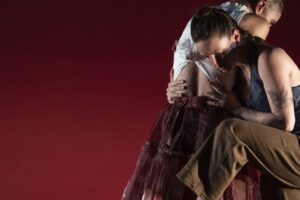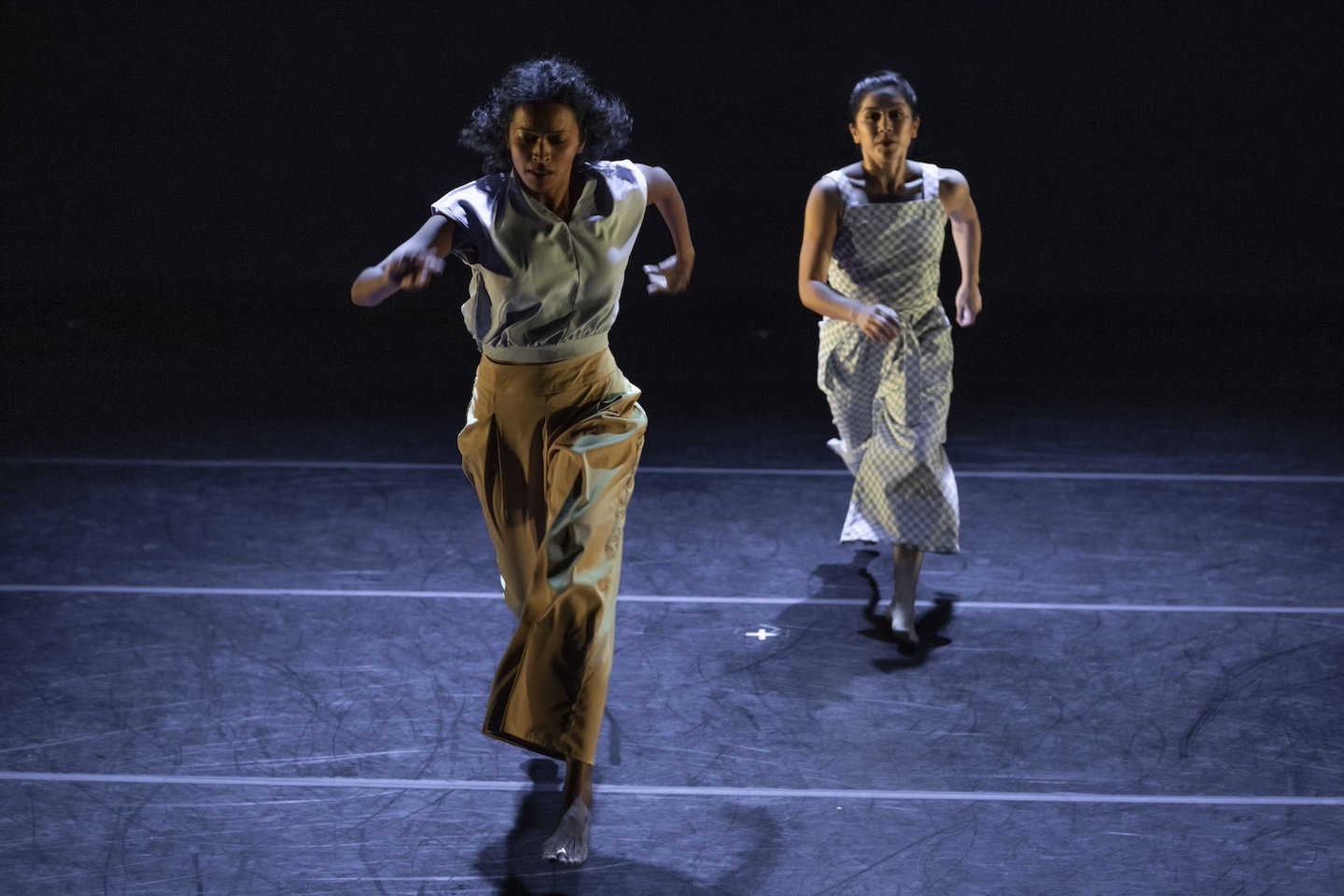Shruti Abhishek and Elizabeth Zepeda in Sisters, Photo by Stephen Texeira
[ID: Color production photo, horizontal shot, darkly lit stage. Two women dancers run toward the camera. South Asian woman on L, Shruti Abhishek, wears gold trousers and light blue top. Latinx woman on R, Elizabeth Zepeda, wears a blue and white checked jumpsuit.]
Craft is the breath of my work. I collaborate with dancers to generate and rigorously fine-tune movement vocabularies specific to each dance, drafting and redrafting, crafting and recrafting until there is nothing extra or unnecessary.
I invite dancers from a variety of backgrounds to explore a different or fresh relationship to our respective formative genres, and to more deeply inhabit the forms we have in common. In this way, I think of craft as empowerment, as our work together is fundamentally co-creative, supporting dancer agency, placing the burden of communication on movement, and imagining an audience that craves the sort of expression only dance can provide.
My latest project, Sisters, is an anthology of dances regarding sisterhood, motherhood, pregnancy, birth, abortion, and death. Created in collaboration with eleven women who span borders of dance forms and life experiences, Sisters reclaims feminism as a celebration of the resilience and power of women, of femininity, of any gender expression; and as a progression toward freedom of choice, identity, and bodily autonomy.
In the summer of 2022, as Roe v. Wade was overturned, my family learned that our ancestor Justine, who emigrated from Sweden to Brooklyn in the mid-1800s, died at seventeen not, as we believed, of influenza, but of sepsis from a self-induced abortion. A series of newspaper articles investigating her death revealed two things: one, that Justine, upon her deathbed, told her sister Johanna (our great-grandmother) the name of the father, and two, that Johanna vowed to carry this secret to her grave.
Using Justine’s story as a base, the dancers and I began by writing and talking about our sororal relationships and the whisper networks of women.
Sisters is composed of solos, duets, a trio and group sections all woven together into a cohesive performance. For this article I’ll focus on a duet created with Bharatanatyam dancer Shruti Abhishek and baile folklórico/modern dancer Elizabeth (Eli) Zepeda. I’ve worked with Eli since she was a teenager, and I know Shruti from when we danced together in a 2019 duet choreographed by Nadhi Thekkek. Though we began by writing about sisterly relationships, the conversation quickly turned to what was really on Shruti and Eli’s minds—their birth stories and early motherhood.
I am not a mother, and while sometimes I feel sad about that, I’ve never felt evolved enough or secure enough to have a child. I’ve seen beautiful mothering, but also motherhood that looked grim. And the pain of childbirth; I’ve had endometriosis since I was a teen and know the excruciating pain of endometrial cysts bursting in my ovaries. Pregnancy was recommended to thwart the endometriosis, but I couldn’t accept the idea of pregnancy as a cure for anything.
I didn’t feel I could make a dance reflecting something I’ve not experienced, but birth and motherhood kept surfacing as the main thematic presences in the room, so I let go of my concerns and bowed to the dance, conscious of the challenge of honoring intimate stories that do not belong to me and translating them into choreography and performance without falling into a pit of literalism.

[ID: Color production photo, horizontal shot, red/orange light. Two women dancers on R side of frame; Maurya Kerr, a black woman on L, wears a white top and dark pink skirt, faces away from camera, head turned R; she is held in a tight embrace by Molly Levy, a white woman to her R, who wears brown pants and blue halter top facing L side of frame in profile, her L knee bent high in embrace.]
Shruti and Eli’s duet begins with all eleven women rushing toward the audience, a wild, space-eating phrase created in response to the question, “what is the movement of a pregnant woman’s water breaking?” In unison, the dancers hurtle forward while maintaining a tight cluster; they careen back and forth across the floor, as if on a ship in a storm. The sequence culminates abruptly with the dancers landing on one leg in a skydiving/flock of birds formation. They struggle, wobble and hop, reaching out to touch a nearby arm, foot, back, stilling themselves, finding balance, and breathing together in community; Shruti and Eli emerge as a duo while the others melt away.
Early on, Eli and Shruti expressed a desire to learn more about each other’s forms, so we devoted several rehearsals to their teaching each other Bharatanatyam and baile folklórico skills and steps. These sessions helped us expand on a repetitive sidestep devised in an earlier rehearsal, a foot pattern that speaks to dance traditions and human movement across the globe. We layered gestures—complicated, meticulous upper body phrases drawn from our stories of sisterhood/birth/motherhood—on top of the stepping pattern, working with a simple 4/4-time structure, no other sound but their light feet tapping time.
Working with these phrases as a base, we designed a spatial pattern taking Eli and Shruti downstage center, forging a runway path toward the audience. Once they reach the audience, they split apart, circling back to where they started. Shruti and Eli dance this sequence in unison, meeting again and again upstage center to start a new pass. Dance critic Heather Desaulniers wrote that for her, this reflected an act of treading water; indeed, our intention was to reflect ideas about mothers holding it down, cool moms at the park making it look easy and lovely while barely containing the inner churn, the fears, frustrations, and craziness of early motherhood.
I rarely use text in my work, but early in the process I began feeling strongly that we needed to hear from Shruti, who has an amazing voice but had never worked with spoken text in dance. Shruti went for it, and her first improvised monologue became the words we used in the dance— the ten-year struggle to obtain a visa for her mother, during which time Shruti gave birth, followed by a more than two-year delay before Shruti’s daughter met her grandmother for the first time. We later added text for Eli, who describes her son’s birth like a shopping list: five days in labor, three visits to the hospital, two shots of morphine, seven days in NICU.
The choreography in this duet explores how bodies hold the fraught, often extreme spaces of early motherhood—a difficult birth and caring for an infant, the greatest love of your life and the greatest challenge—and for many, in a new country and home, without family support, and how birth changes women’s bodies and relationships with the world.
As a choreographer and dancer in my sixties I have learned that I can only move in this body, in this moment, offering intimate presence as connection and valuing dance as critical to our survival. I come seeking the dance that needs to be made, asking who we are in this place together. To me dance is rooted in hope, the work of small transformations. This is not about me as a dance artist; this is about dance, about the work of our work, knowing ourselves better, evolving, so we can better relate to each other and to the world.
Sisters premiered at ODC Theater as part of their State of Play series, August 2024.
This article appeared in the Fall 2024 issue of In Dance.


